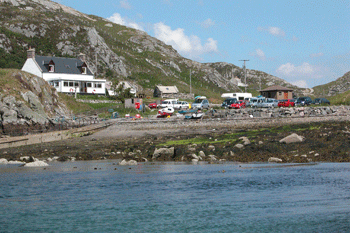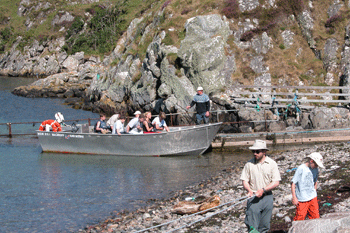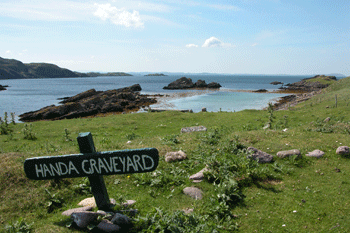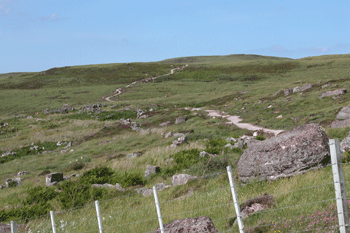
Mackay Country
Dùthaich Mhic Aoidh
An area in North-West Scotland of natural unspoiled beauty, rich in heritage & history
Handa Island



Handa is an island surrounded by high sea-cliffs lying a short distance from the west coast of Sutherland in Scotland. Located on the western coastline of Highland Council Area, Handa Island sits across the Sound of Handa from the village of Scourie. The departure point for Handa Island is at Tarbert – 6 miles north of Scourie. Passenger ferries sail from Tarbet and the island is now in the care of the Scottish Wildlife Trust. The island is owned by Dr. Jean Balfour and managed for its wildlife by the Scottish Wildlife Trust (SWT). On landing on the island a SWT warden will point you in the direction of the footpath which encircles the island. The complete trail is 6 km and takes at least 2 hours, it is best to allow 3 to 4 hours or more to fully appreciate the sights and sounds of Handa. The terrain is rough, the cliffs are steep and the weather can change quickly.



Covering an area of 309 ha (764 acres), this small island was once inhabited by 12 families until 1846 when the famine forced them to leave because of the potato crop failure. They lived mainly on fish potatoes and seabirds. The residents of this island used to appoint their own parliament and the oldest widow in the community was made their queen. Similar to that on St Kilda in fact. Since then it has become a haven for bird-life; puffins, razorbills, kittiwakes and guillemots all breed here. It provides a strategic nesting locality for seabirds that feed in the productive waters of the northern Minch, outside the SPA. Most of the island is vegetated with sub-maritime grasslands and heaths. The SPA’s principal ornithological importance is for its breeding seabirds. The only inhabitant now is a Scottish Wildlife Trust warden and their team of volunteers. Handa Island is a dedicated bird reserve and Site of Special Scientific Interest. Over 170 bird species have been recorded here and the island hosts one of the largest guillemot colony in Britain – about 75,000 birds. Probably the most unusual bird – an albino oystercatcher with a twisted bill – now resides, stuffed, in an Edinburgh museum having died on Handa in 1967. 216 species of plant have been recorded and over 100 types of moss. Thousands of rabbits reside here and whales are seen fairly frequently.


Handa was also an important burial ground where the bones of dead mainlanders could be laid to rest safe from the wolves that marauded Scotland in those days. Today there is one marked grave on the island.
Walkers continue at their own pace from the bothy on the track. The first encounter that reveals one time habitation is the ruins of dwellings where the 60 people were evacuated from by their own request. The ruined houses are all together some only foundations are apparent others have walls. What is most striking are the straight uniform lines they are built in and remind the traveller of the story of St. Kilda. There is no interpretation on the island only a printed leaflet for further explanation.
The walkers around the island encounter some interesting and fascinating views with bird colonies on the stacks and rocks are abundant. The walking is made relatively easy on wooden walkways with an ability to watch the wildlife all around. The flora and fauna are apparently unperturbed by the visitors.
Puffins nest in burrows on top of the Stack, probably because of introduced brown rats. Following the eradication of rats from Handa in 1997, puffins have started to colonise the main island again. Over 9,000 guillemots alone breed on ledges on the Stack’s east-face. Razorbills lay their single egg on crevices near the top of the Stack. Kittiwakes build nests made of grass cemented together by droppings.
The Great Stack or Stack an Seabhaig (the hawk’s stack) is the best place to experience the sight, sound and smell of its guano-splashed cliffs during summer of some of Handa’s 180,000 seabirds. The stack is a pillar of sandstone separated from the island by the sea a huge chunk of red Torridon sandstone surrounded by sheer cliffs, carpeted with machair and purple-tinged moorland, and teeming with seabirds. The Best time to visit is between April to July for Guillemots, puffins and razorbills. May to September for arctic skuas, fulmars, kittiwakes and Great skuas, if you’re too close to the Great Skuas they’ll dive bomb you and drop stones on you. June through to August is the best time to see the wild flowers.


HANDA ISLAND, OS ref.: NC 13/48 OS map: sheet 9
Handa, an off shore island with sea cliffs and one of the largest seabird colonies in N.W. Europe, is a bird sanctuary owned by Dr. Jean Balfour and managed for its wildlife by the Scottish Wildlife Trust. It is situated a mile or two from the mainland opposite Scourie Bay. This tiny island, measuring about one mile by one and a half miles, was once inhabited by twelve families’ home to 65 people in 1841, who appointed their own daily parliament to allocate the work that needed doing and queen – the oldest widow in the community. The islanders lived on potatoes, fish and seabirds. It was also an important burial ground where the bones of dead mainlanders could be laid to rest safe from the wolves that maraudered Scotland in those days. In 1846 the tradition died when the potato famine food crops failed due to potato blight and forced the islanders to leave for the mainland and migration to Canada and it has been uninhabited since. The ruins of their houses can still be seen.
In the north west of the island the magnificent sea cliffs, formed from horizontally stratified Torridonian sandstone, rise vertically from the Atlantic. Each summer they come alive, when nearly 200,000 seabirds gather to breed. Guillemots, razorbills, and great skuas reach internationally important numbers. There are also kittiwakes, arctic skuas and some puffins, attractive plant-life and archaeological remains
The ferry to Handa Island runs regularly from April to early September, Monday to Saturday from 9.30am to 2.00pm, with a last return at 5.00 pm. The return trip costs £7.00 for adults and £3.50 for children. Most visitors spend at least 2 1/2 to 3 hours on the island. Visitors are asked to make a small contribution to the cost of managing the island.
On the arrival at the island about ten minutes later from Tarbet in the boat either the Handa ranger, warden or one of the volunteers meets the passengers. After a welcome the group is taken on a short walk to the bothy where an introductory talk, with an opportunity to view the displays, about the wildlife and history of the Island. Follow the footpath around the island – an easy and enjoyable walk taking in the north shore’s Great Stack rock pillar and some fine views across the Minch: a detailed route guide is featured in the free leaflet, available from the warden’s office when you arrive.
Handa rises to a height of 400ft and measures about a mile by a mile and a half. It is a Site of Special Scientific Interest and is run as a nature reserve by the Scottish Wildlife Trust. Over 170 species of birds can be seen on Handa, including the 100,000 resident guillemots, along with 216 species of plants and 100 mosses. The walk around the island is circular and although this does not cover the whole island the essence of the reserve and its sights are all taken in.

Handa Island is internationally famous for its sea-bird colonies, including the one of the largest breeding colonies of guillemots in Britain and there are estimated to be around 40,000 pairs of breeding on Handa! There are also puffin, fulmar, shag, razorbill, skuas (both Arctic and great), kittiwake, gulls and terns. Handa is renowned for its magnificent Torridonian Sandstone cliffs, which rise to a height of 400 feet along the dramatic northern edge of the island. Thousands of years of weathering of the sandstone has formed horizontal layers which provide ideal disturbance free places for seabirds to breed. Many of Handa’s seabirds, which can live for 20 years or more, return to exactly the same spot on the cliff year after year. In these sea-bird ‘cities’ each pair holds a territory of a few square feet, which is essential for breeding. From mid-July onwards the seabirds begin to leave the cliffs to spend the winter out at sea. The moorland of the interior is home to Arctic and great skuas. It is worth pausing for a moment to watch their spectacular flying displays. The great skua, or bonxie, is a powerful bird which will often bully other seabirds and make them disgorge their fish. They also rob kittiwake eggs and chicks and will regularly kill other species. Great skuas will attack and sometimes drown a bird as large as a gannet. They can be aggressive in defence of their eggs and young, and may swoop low enough to strike an intruder’s head with their feet. The Arctic skua is noisy and demonstrative. During their graceful flying displays they show a complete mastery of the air.
“In 1848 Evander Maciver cleared Handa Island and Sheigra. He took Handa as part of his own lease for sheep and turned Sheigra into a sheepwalk too”
P74 M. Bangor-Jones


Much of their food is obtained by chasing other seabirds and forcing them to drop or disgorge their catch. On the breeding ground this species can be even more aggressive than the great skua, dive-bombing at human or animal intruders as well as other skuas. The Great Stack is the best place to experience the excitement and clamour of Handa’s 100,000 seabirds.
Over 7,000 guillemots alone breed on the ledges on the stack’s east face. Puffins nest in burrows on top of the stack where they probably retreated to avoid predation by the introduced brown rats. Following the successful eradication of rats in 1997, puffins are just beginning to recolonise the main island. As you walk along the cliff watch the graceful fulmars in flight. They are superb flyers and can hang almost motionless as they ride the air currents on straight narrow wings. Fulmars nest on narrow ledges near the top of the cliffs. For about eight weeks male and female take turn to brood the single egg, usually for spells of two to five days. Guillemots and razorbill are generally found below the fulmars. Razorbill lay their single egg in crevices. Guillemots nest in packed communities and often share eggs, chicks and mates. Kittiwakes build their nests even lower down on narrow ledges. Their nests are made of grass cemented together by droppings. Kittiwake are true ocean gulls and only come ashore to breed, spending the long winter months at sea.
You may also see many of the area’s marine wildlife such as dolphins, porpoises, seals and the occasional whale. Minke whales, which are the whales most commonly seen from Handa, have a small dorsal fin two thirds of the way down their back.

